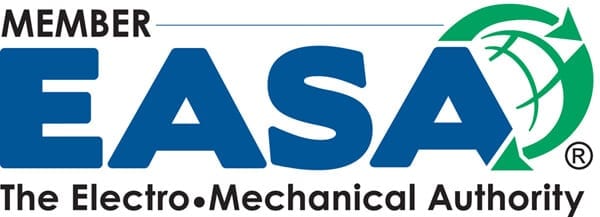Frequently Asked Questions
What are NEMA and IEC motors?
Specifications for industrial low voltage motors are established by NEMA for motors typically manufactured in North America and by IEC for motors manufactured in the rest of the world. NEMA motors are based on the English or Imperial standard and IEC motors are based on the metric standard. So a NEMA motor would be measured in inch dimensions and rated in horsepower and an IEC motor would be measured in millimeters and rated in kilowatts. These standards cover power, speed, mounting dimensions and shaft dimensions regardless of the manufacturer.
How do I determine the frame size of my motor?
NEMA frames are sized 140 through 440. The shaft height of the motor times 4 would give you the frame size. So a motor with a 10” shaft height would be a 400 series frame. With IEC motors, the frame sizes run 56 through 400. The shaft height in millimeters is the actual frame size. So a motor with a 160 millimeter shaft height would be a 160 frame.
What are the different suffixes for NEMA frames?
Suffixes are added to denote specifics within a given frame size. For instance, a modern 440 frame motor will typically end with a “T” which is a standard frame motor. Each frame size can have a “TS” suffix to specify a short shaft design, a “TC” to specify addition of a C-face or “TD” to specify addition of a D-flange. You may also find combinations of these such as “TSC” or “TDC”. Any frame ending with the letter “Z” typically has a special dimensional feature that is non-standard such as shaft length or diameter. You can refer to our frame size chart for more specifications.
What do specifications do I need to know in order to replace a motor?
At a minimum, you will need to know the power (hp or kw), the rpm, the frame size, the operating voltage and the type of enclosure.
What are the types of enclosures for electric motors?
The most common enclosures are TEFC (totally enclosed, fan cooled), and ODP (open, drip proof). You will also see TENV (totally enclosed, non-ventilated), TEAO (totally enclosed, air over), TEBC (totally enclosed, blower cooled) and, for medium voltage motors, you will see WP1 (weather protected type 1) and WP2 (weather protected type 2).
How are the speeds determined for electric motors?
The typical speeds for NEMA motors are 3600 rpm, 1800 rpm, 1200 rpm and 900 rpm although there are exceptions down to 600 rpm and lower as well. IEC motors are typically rated by the number of “poles” in the winding. This is done to help eliminate confusion between 50 hz and 60 hz speed differences. The pole designations correspond to the same speeds as NEMA uses with 3600 rpm being 2 pole, 1800 rpm being 4 pole, 1200 rpn being 6 pole and 900 rpm being 8 pole.
What is the operating voltage of my NEMA motor?
Alternating current (AC) electric motors in the United States fall into two voltage categories, single phase and three phase. Single phase motors will typically be either 110 volt or 220 volt. These can also be listed as 115 volt and 230 or 240 volt depending on the transformer arrangement at a given location. Three phase motors will typically be 230 or 460 volt with 220 or 240 volt and 440 or 480 volt being the equivalent voltages of varying transformer arrangements. Each grouping of voltages (i.e. 440, 460 and 480) will work interchangeably with rare exceptions. All of the voltages have a line frequency of 60 hz. Although more common in Canada than the United States, 575 volt motors can be found in the northern states and a few scattered throughout the rest of the country. In rural areas, 208 volt is also a fairly common rating and can usually interchange with 220/230/240 volt motors although higher amperage can be expected with the lower voltage. When in doubt, always check the motor nameplate or contact the manufacturer.
What is the operating voltage of my IEC motor?
IEC motors are usually classified by their European line frequency rating of 50 hz. Typical voltages at the frequency are 230, 380, 400, 415 and 690. Do not confuse European 230 volt with North American 230 volt motors!
Can I operate a 50 hz motor on 60 hz?
Absolutely, as long as you check your math and your connections. A 380, 400 or 415 volt 50 hz motor will operate fine at 460-480 volts 60 hz as long as you connect it properly. Amperage reading will vary depending on the difference between the 50 hz rated voltage and the 60 hz operating voltage. The frequency to voltage ratio conversion is a factor of 1.2 (60 hz divided by 50 hz) so a motor rated at 400 volts, 50 hz can be operated at 480 volts (400 x 1.2 = 480) with little to no losses with slight losses being acceptable at 460 and 440 volts. When in doubt, always check the motor nameplate or contact the manufacturer.


